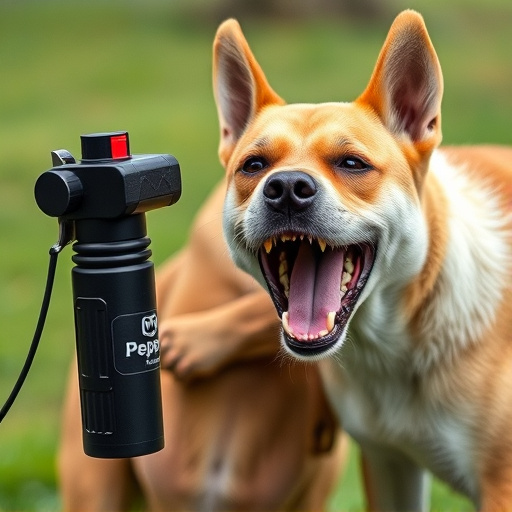The Mace Formula Animal Pepper Spray is a safe yet powerful tool for training dogs to defend against aggression, using capsaicin from chili peppers to temporarily disable behavior. Effective pepper spray dog defense drills involve controlled exposure in training, strategic application targeting sensitive areas, and regular practice with various methods to enhance preparedness. Legal considerations vary by region, so understanding local regulations is crucial. These drills aim to teach dogs calm protection without severe harm, benefiting both individuals and animals in dangerous situations.
Discover the power of mace formula animal pepper spray as a vital tool for dog defense. This potent solution offers an effective way to deter potential threats, providing peace of mind for pet owners. In this comprehensive guide, we explore the science behind its ingredients and their efficacy against various scenarios. Learn through practical drills how to train your dog to respond appropriately in real-world situations, along with expert tips on application techniques. Also covered: legal aspects and safety precautions to ensure responsible use.
- Understanding Mace Formula Animal Pepper Spray: Ingredients and Efficacy
- Training with Pepper Spray: Dog Defense Drills for Real-World Scenarios
- Application Techniques: Maximizing the Impact of Your Pepper Spray
- Legal Considerations and Safety Precautions for Pepper Spray Use in Dogs
Understanding Mace Formula Animal Pepper Spray: Ingredients and Efficacy
Mace Formula Animal Pepper Spray is a powerful tool designed for effective dog defense drills. Understanding its ingredients and efficacy is crucial when considering this type of self-defense mechanism. The spray typically contains capsaicin, the active ingredient found in chili peppers, which is known to cause temporary blindness, coughing, and difficulty breathing in dogs. This natural compound is safe for humans but can be highly effective in deterring aggressive canine behavior.
The formula’s effectiveness lies in its ability to create a distracting and painful experience for the dog, allowing you time to escape or seek help. Unlike traditional pepper spray designed for human self-defense, animal pepper spray is specifically crafted to disrupt and discourage attacks without causing severe harm. This makes it an ideal choice for individuals who encounter aggressive dogs during outdoor activities or while walking their own pets. By employing effective pepper spray dog defense drills, users can enhance their safety and that of their animals in potentially dangerous situations.
Training with Pepper Spray: Dog Defense Drills for Real-World Scenarios
Training with pepper spray is an essential component of preparing dogs for real-world defense scenarios. When it comes to dog defense drills, effective pepper spray usage can be a game-changer in intimidating potential threats. Start by introducing your dog to the scent and sensation of pepper spray in a controlled environment. Use specialized training aids that mimic the effects without causing lasting harm, allowing your dog to associate the stimulus with a temporary but powerful deterrent.
Incorporate various real-world scenarios into these drills. Practice sudden movements and distractions to simulate unexpected encounters. Teach your dog to respond calmly under pressure by rewarding consistent behavior during training sessions. The goal is to make your dog aware of its protective capabilities without inducing fear or unnecessary aggression. Effective pepper spray dog defense drills should enhance the animal’s natural instincts, making it a reliable companion in potentially dangerous situations.
Application Techniques: Maximizing the Impact of Your Pepper Spray
When it comes to using mace formula animal pepper spray, understanding application techniques is key to maximizing its impact during dog defense drills. For starters, aim for the face—the eyes, nose, and mouth are particularly sensitive areas. A direct blast can temporarily blind and disorient your target, providing you with a crucial window of opportunity to escape or gain control. Practice steady, controlled bursts rather than a single powerful spray; this ensures a more precise and effective coverage.
Remember that consistency is vital. Repeated applications at regular intervals significantly enhance the pepper spray’s effectiveness. In dog defense scenarios, quick follow-up sprays can disrupt a dog’s attack pattern, giving you better control over the situation. Additionally, training in various application methods—handheld spraying, spray sticks, or even specialized equipment—can improve your efficiency and overall preparedness during real-life situations.
Legal Considerations and Safety Precautions for Pepper Spray Use in Dogs
When considering the use of pepper spray as a defensive tool for dogs, it’s crucial to navigate legal boundaries and prioritize safety precautions. The legality of using pepper spray on animals varies by region, so understanding local regulations is essential. In many places, pepper spray is permitted for dog defense but must be used responsibly and according to specific guidelines.
Safety is paramount when employing effective pepper spray dog defense drills. These include ensuring the spray is targeted accurately, as misting eyes or sensitive areas can cause harm. Users should also consider the distance at which the spray will be deployed, minimizing risk to bystanders. Regular training and familiarization with the product are vital to guarantee its safe and effective use in stressful situations.
Mace formula animal pepper spray, with its potent ingredients and demonstrated efficacy, serves as a valuable tool for dog owners seeking to enhance their pet’s safety. Through targeted training using effective pepper spray dog defense drills, owners can equip their canines with the skills needed to navigate real-world scenarios confidently. By mastering application techniques and adhering to legal considerations and safety precautions, responsible dog guardians can ensure their four-legged companions remain protected without causing undue harm. Embracing these practices contributes to a holistic approach to canine welfare in today’s diverse and sometimes unpredictable environment.
